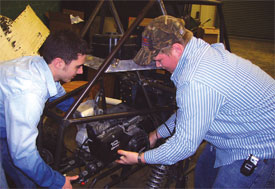Building the Mini Baja
- February 28, 2006
- |
- Kevin Teets, Senior Reporter
- Section: Cover
A competitive mini-Baja vehicle needs to pull logs, operate in up to five feet of water, maneuver around trees, navigate on rough terrain and pass an endurance test.
Eleven UTM engineering students are working diligently to be competitive in the 2006 Mini Baja East Competition.
Senior project manager Darin Cate of Bruceton says that he and his team started building this year’s mini-Baja vehicle last May. The 2006 Mini Baja East Competition is being held in Auburn, Ala., this year and is less than two months away. “So far we are staying on schedule,” Cate says. “We are two weeks away from having it running.”
More than 70 universities from the Eastern United States and Canada compete in the competition. The competition gives engineering students a chance to showcase their skills and expertise in designing a vehicle that can take on some very challenging courses.
Competition events include courses dealing with suspension and traction, land maneuverability, water maneuverability, incline testing, acceleration, and a log pull.
The suspension and traction competition will consist of vehicles having to navigate in a ravine with a cleared Eastern woodland forest floor. The drivers will also have to maneuver around trees and recover from hitting any trees without getting out of their car. The water maneuverability section of the course will require vehicles to start and finish on land and survive a splash in a pond that can be up to five feet deep. In the log pull section, vehicles will be required to pull telephone poles on rolled dirt with a possible incline.
Successful completion in the endurance race part of the competition will require a vehicle that can survive a 100-mile race, navigating through many of the obstacles experienced in the other competition areas.
Senior engineering student Greg Peppard of Woodlawn, Tenn., says that he expects UTM’s mini-Baja vehicle to be the most competitive in the area of water maneuverability. “We have very good flotation and fender setup,” Peppard says. “Last year we placed fourth in this area.”
Peppard also says that the team has made a few changes in their design this year to correct some mistakes that the team experienced last year. “Last year our frame broke. It’s not going to break this year,” Peppard says. Despite having a broken frame, UTM’s team placed 23rd out of 72 schools in the 2005 competition.
The team is advised by engineering professor Robert LeMaster and includes students Darin Cate, Katie Childress, Phillip Casterline, Greg Peppard, Daniel Hampton, Bryan Boggs, Kenny Lee, Muammer Aykin, Fong-An Kan, Andrew Lykins and Evan Trevathan.
Childress, the only female on the team, says she enjoys working on the project. “I think this is a challenging experience. I love working with my teammates,” Childress says.
The students that work on the mini-Baja project say they are always looking for sponsors to help fund the competition. Cate says he expects this year’s vehicle to cost at least five thousand dollars. Costs would be even more expensive if it were not for some donated materials and machine work.
The mini-Baja competitions are sponsored by the Society of Automotive Engineers (SAE). The UTM team is known as UTM Motorsports.
